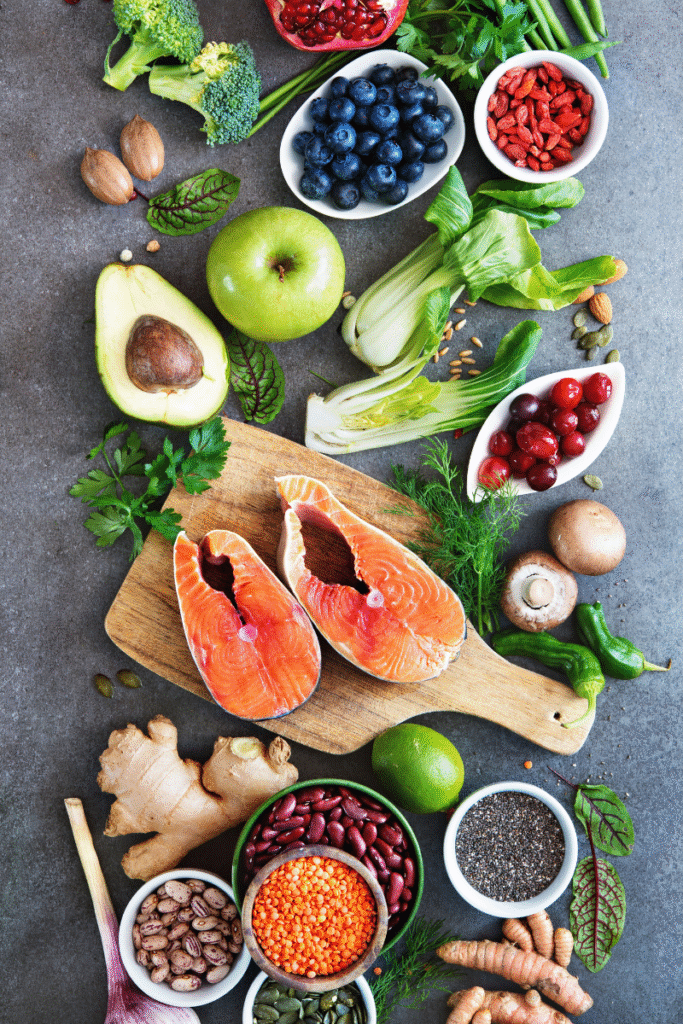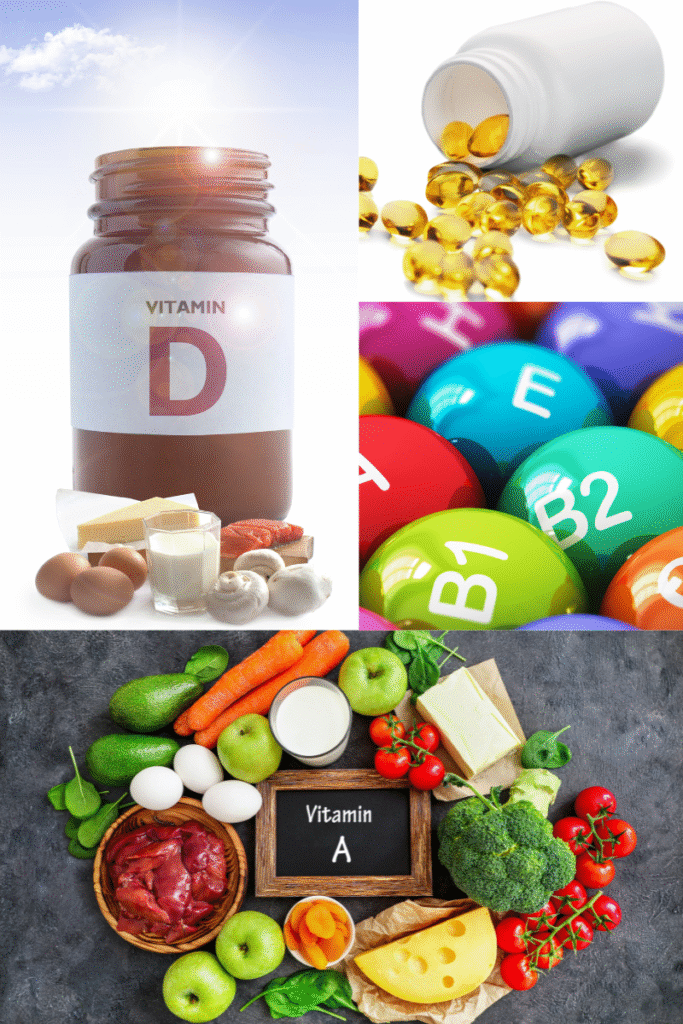Do you find yourself reaching for chocolate during an emotional moment, only to experience a hot flash shortly after? Have you noticed that your morning coffee now triggers anxiety or that glass of wine leads to night sweats? Or perhaps you’re wondering why your energy levels seem to crash at 3 PM despite getting adequate sleep?
The connection between what we eat and how we feel during perimenopause is powerful yet often overlooked. As hormone levels fluctuate during this transition, your nutritional needs change, and certain foods can either exacerbate symptoms or help alleviate them.
In this comprehensive guide, we’ll explore the science behind the food-hormone connection, identify key nutrients that become especially important during perimenopause, and provide practical strategies—including delicious recipes—to help you use your kitchen as medicine during this transition.
The Hormone-Food Connection
To understand why nutrition becomes so crucial during perimenopause, it helps to understand how food interacts with your hormonal system.
How Food Affects Hormone Production and Metabolism
Every bite you take influences your hormones in multiple ways:
- Provides building blocks: Certain nutrients like healthy fats are essential for hormone production
- Affects insulin response: Blood sugar fluctuations impact other hormones, including stress hormones and sex hormones

- Influences estrogen metabolism: Some foods can help your body process estrogen more effectively
- Supports or hinders detoxification: Your liver needs specific nutrients to properly metabolize hormones
- Impacts gut health: The microbiome plays a crucial role in hormone regulation and metabolism
During perimenopause, when estrogen and progesterone levels are already fluctuating unpredictably, these food-hormone interactions become even more significant.
The Role of Inflammation in Perimenopausal Symptoms
Inflammation is a key factor in many perimenopausal symptoms, including:
- Hot flashes and night sweats
- Joint and muscle pain
- Mood swings and irritability
- Sleep disruption
- Brain fog and cognitive changes
What you eat can either fuel inflammation or help reduce it. Pro-inflammatory foods like refined carbohydrates, trans fats, and excessive sugar can intensify perimenopausal symptoms, while anti-inflammatory foods like fatty fish, leafy greens, and berries can help moderate them.
How Blood Sugar Fluctuations Impact Hormonal Symptoms
Blood sugar instability is particularly problematic during perimenopause because:
- It triggers stress hormones: When blood sugar drops, your body releases cortisol and adrenaline, which can worsen hot flashes and anxiety
- It affects sleep quality: Blood sugar dips during the night can trigger night sweats and sleep disruption
- It impacts mood stability: Rapid rises and falls in blood sugar can exacerbate mood swings
- It increases cravings: Blood sugar crashes lead to cravings for quick energy (usually sugar or refined carbs), creating a vicious cycle
Many women find that stabilizing blood sugar through dietary changes significantly improves their perimenopausal symptoms.
The Gut-Hormone Connection and Its Importance
Emerging research highlights the crucial relationship between gut health and hormonal balance:
- Your gut microbiome helps regulate estrogen levels through what’s called the “estrobolome”—the collection of bacteria that metabolize estrogen
- Gut bacteria produce neurotransmitters that affect mood and sleep
- Intestinal permeability (“leaky gut”) can increase systemic inflammation, worsening perimenopausal symptoms
- Digestive health affects nutrient absorption, which impacts hormone production
Supporting gut health becomes especially important during perimenopause as your body adapts to changing hormone levels.
Common Nutritional Deficiencies During Perimenopause

As your body transitions through perimenopause, certain nutrients become even more important, yet many women become deficient in these key elements.
Magnesium and Its Role in Over 300 Bodily Processes
Magnesium is often called the “missing mineral” in perimenopause because:
- It helps regulate the nervous system and reduce anxiety
- It supports sleep quality and can reduce insomnia
- It’s crucial for energy production at the cellular level
- It helps prevent muscle cramps and tension
- It supports bone health as estrogen declines
- It aids in maintaining healthy blood sugar levels
Unfortunately, modern farming practices have reduced the magnesium content in many foods, and stress—common during perimenopause—depletes magnesium stores. Additionally, certain medications and excessive caffeine or alcohol can further deplete this essential mineral.
Signs of magnesium deficiency include muscle cramps, tension headaches, constipation, irritability, and sleep problems—symptoms often attributed to perimenopause itself rather than a nutritional deficiency.
B Vitamins and Their Impact on Energy and Mood
The B vitamin family plays crucial roles during perimenopause:
- B6: Helps with mood regulation and can reduce irritability
- B12: Supports energy production and cognitive function
- Folate: Works with B12 for cellular energy and mood stability
- B5: Supports adrenal function and stress response
- B1, B2, B3: Essential for energy production and nervous system function
B vitamin deficiencies can manifest as fatigue, brain fog, irritability, and mood changes—all commonly experienced during perimenopause. Women with heavier periods during perimenopause may be particularly susceptible to B vitamin deficiencies due to increased blood loss.
Omega-3 Fatty Acids and Inflammation
Omega-3 fatty acids are essential fats with powerful anti-inflammatory properties that become especially important during perimenopause:
- They help moderate the inflammatory response that can worsen hot flashes
- They support brain health and cognitive function
- They contribute to mood stability and may help prevent depression
- They benefit cardiovascular health as heart disease risk increases post-menopause
- They support skin health as estrogen-related skin changes occur
The standard Western diet typically contains insufficient omega-3s while providing excessive omega-6 fatty acids, creating an imbalance that promotes inflammation.
Vitamin D and Its Multiple Benefits
Vitamin D deficiency is extremely common and particularly relevant during perimenopause because:
- It works synergistically with calcium for bone health as osteoporosis risk increases
- It plays a role in mood regulation and may help prevent seasonal affective disorder
- It supports immune function
- It may help reduce inflammation
- Some research suggests it could help moderate certain perimenopausal symptoms
Living in northern latitudes, spending most time indoors, and using sunscreen (important for skin health) all contribute to widespread vitamin D deficiency.
Iron Considerations with Heavier Periods
Iron status requires special attention during perimenopause because:
- Many women experience heavier or more frequent periods during perimenopause, increasing iron loss
- Iron deficiency can cause fatigue, hair loss, and cognitive issues that may be mistaken for other perimenopausal symptoms
- However, iron overload can also be problematic for some women, so supplementation should be based on testing
Monitoring iron status through appropriate blood tests becomes important during this transition, especially for women experiencing heavy bleeding.
Foods That Support Hormonal Balance
Certain foods contain compounds that can help moderate the hormonal fluctuations of perimenopause.
Phytoestrogen-Rich Foods
Phytoestrogens are plant compounds with mild estrogen-like activity that may help balance hormonal fluctuations:
- Flaxseeds: Contain lignans that can help moderate estrogen activity
- Soy foods: Traditional forms like tempeh, tofu, and edamame (not highly processed soy isolates)
- Legumes: Especially chickpeas, lentils, and split peas
- Sesame seeds: Contain lignans similar to flaxseeds
- Berries: Particularly strawberries and cranberries
Research suggests that modest consumption of these foods may help reduce hot flashes and support overall hormonal balance during perimenopause. The effect is generally gentle and supportive rather than powerful like hormone replacement therapy.
Healthy Fats for Hormone Production
Hormones are made from fats, so adequate healthy fat intake is essential during perimenopause:
- Avocados: Rich in monounsaturated fats and fiber
- Olive oil: Contains anti-inflammatory compounds and monounsaturated fats
- Nuts and seeds: Provide essential fatty acids and minerals
- Fatty fish: Salmon, sardines, mackerel, and herring provide omega-3s
- Coconut oil: Contains medium-chain triglycerides that support energy production
These fats help maintain cell membrane integrity, support brain health, and provide the building blocks for hormone production.
Fiber-Rich Foods for Estrogen Metabolism
Dietary fiber plays a crucial role in healthy estrogen metabolism:
- Cruciferous vegetables: Broccoli, cauliflower, cabbage, and Brussels sprouts contain compounds that support estrogen detoxification
- Ground flaxseeds: Provide both fiber and lignans that support hormone balance
- Leafy greens: Spinach, kale, collards, and other greens provide fiber and essential nutrients
- Berries: High in fiber and antioxidants
- Legumes: Beans, lentils, and peas provide both fiber and plant protein
Fiber helps remove excess estrogen from the body through the digestive tract, supporting hormonal balance. Aim for 25-35 grams of fiber daily from a variety of sources.
Antioxidant-Rich Foods for Cellular Health
Antioxidants help protect cells from oxidative stress, which increases during perimenopause:
- Colorful fruits and vegetables: The more varied your color intake, the broader your antioxidant protection
- Dark chocolate: Contains flavanols that support vascular health (choose 70%+ cocoa content)
- Green tea: Provides L-theanine for stress reduction along with antioxidants
- Herbs and spices: Turmeric, ginger, cinnamon, and others provide concentrated antioxidants
- Berries: Especially blueberries, blackberries, and raspberries
These foods help combat the increased oxidative stress that occurs with aging and hormonal fluctuations.
Adaptogenic Herbs and Their Benefits
Adaptogens are herbs that help the body adapt to stress and support overall balance:
- Ashwagandha: May help moderate cortisol levels and reduce anxiety
- Rhodiola: Supports energy and stress resilience
- Holy basil (Tulsi): Helps balance stress hormones and supports mood
- Maca root: Traditionally used to support hormonal balance
- Shatavari: Used in Ayurvedic medicine to support women’s hormonal health
While research on adaptogens specifically for perimenopause is still emerging, many women report benefits from incorporating these herbs into their diets through teas, powders added to smoothies, or cooking.
Foods That May Worsen Perimenopause Symptoms
Just as some foods can help ease perimenopause symptoms, others can trigger or intensify them. 

Caffeine and Its Impact on Hot Flashes and Sleep
Caffeine affects women differently during perimenopause:
- It can trigger or intensify hot flashes in some women
- It may increase anxiety and heart palpitations
- It can disrupt sleep, especially when consumed after noon
- It may increase breast tenderness
- It can contribute to bone loss if consumed excessively
Many women find they become more sensitive to caffeine during perimenopause and need to reduce their intake or switch to lower-caffeine alternatives like green tea.
Alcohol Effects on Hormones and Sleep
Alcohol can be particularly problematic during perimenopause because:
- It often triggers or intensifies hot flashes and night sweats
- It disrupts sleep architecture, reducing restorative deep sleep
- It stresses the liver, which is already busy processing changing hormone levels
- It can increase anxiety and depression symptoms
- It may contribute to weight gain, particularly around the midsection
While an occasional glass of wine might be fine for some women, others find even small amounts of alcohol significantly worsen their perimenopausal symptoms.
Sugar and Refined Carbs’ Impact on Mood and Energy
Foods that cause rapid blood sugar spikes can be particularly troublesome during perimenopause:
- They create energy crashes that can trigger hot flashes
- They contribute to mood swings and irritability
- They promote inflammation throughout the body
- They can worsen sleep quality
- They often lead to cravings and overeating
Reducing refined carbohydrates and added sugars is one of the most effective dietary changes many women make during perimenopause.
Common Trigger Foods for Hot Flashes
Beyond caffeine and alcohol, other common hot flash triggers include:
- Spicy foods
- Very hot foods and beverages
- MSG (monosodium glutamate)
- Sulfites (found in wine and some preserved foods)
- For some women, specific trigger foods like chocolate or aged cheeses
Keeping a symptom journal can help identify your personal triggers, as they vary significantly from woman to woman.
Individual Variation and the Importance of Personal Observation
Perhaps the most important thing to understand about nutrition during perimenopause is that individual responses vary tremendously. What triggers symptoms in one woman may be fine for another.
This is why personal observation through food and symptom tracking becomes so valuable. A simple journal noting what you eat and how you feel afterward can reveal patterns specific to your body that no general guide could provide.
The Perimenopause Plate: Building Balanced Meals

Creating meals that support hormonal balance during perimenopause involves understanding the right proportions and combinations of nutrients.
Protein Needs During Perimenopause
Protein becomes increasingly important during perimenopause because:
- It helps maintain muscle mass as metabolism changes
- It provides steady energy without blood sugar spikes
- It supports neurotransmitter production for mood stability
- It helps reduce cravings and maintain satiety
Aim for 20-30 grams of protein per meal from sources like:
- Lean meats and poultry
- Fish and seafood
- Eggs
- Legumes and beans
- Tofu and tempeh
- Greek yogurt and kefir
- Quality protein powders for smoothies
Carbohydrate Considerations and Blood Sugar Balance
Carbohydrates aren’t the enemy during perimenopause, but the type and amount matter significantly:
- Focus on complex carbohydrates that provide steady energy
- Pair carbohydrates with protein and healthy fats to slow digestion
- Consider your activity level when determining portion sizes
- Be mindful of timing—some women do better with more carbs earlier in the day
- Listen to your body’s response—energy levels, mood, and cravings provide feedback
Good carbohydrate choices include:
- Sweet potatoes and other starchy vegetables
- Whole grains like quinoa, brown rice, and oats
- Legumes (which provide both carbs and protein)
- Fresh fruits (especially berries and apples)
- Small amounts of higher-quality sweeteners like maple syrup or honey when needed
Healthy Fat Importance and Selection
Include a source of healthy fat at each meal to:
- Support hormone production
- Increase satiety and reduce cravings
- Provide sustained energy
- Absorb fat-soluble vitamins
- Support brain health
Excellent fat sources include:
- Avocados
- Olives and olive oil
- Nuts and seeds
- Fatty fish
- Coconut and coconut oil
- Grass-fed butter or ghee (if dairy is tolerated)
Portion Guidance and Meal Timing
During perimenopause, how and when you eat can be as important as what you eat:
- Regular meals: Eating at consistent times helps stabilize blood sugar and hormones
- Moderate portions: Metabolism often slows during perimenopause, requiring adjustment in portion sizes
- Plate composition: Aim for half your plate as non-starchy vegetables, one-quarter protein, and one-quarter complex carbohydrates, with healthy fats incorporated
- Earlier dinner times: Many women find that eating dinner at least 3 hours before bedtime improves sleep quality
- Mindful eating: Slowing down and eating without distractions improves digestion and satisfaction
Hydration Strategies and Importance
Proper hydration becomes even more crucial during perimenopause:
- It can help reduce hot flash intensity
- It supports detoxification processes
- It maintains skin elasticity as estrogen-related changes occur
- It helps prevent constipation, which can worsen with hormonal changes
- It supports overall energy and cognitive function
Beyond plain water, consider:
- Herbal teas like peppermint, ginger, or chamomile
- Infused waters with cucumber, berries, or citrus
- Electrolyte-enhanced water, especially if experiencing night sweats
- Bone broth for additional minerals and protein
Aim for approximately half your body weight in ounces of fluid daily, with additional hydration during exercise or hot weather.
Meal Planning for Symptom Management
Strategic meal planning can significantly reduce perimenopausal symptoms while simplifying daily food decisions.
Strategies for Consistent Eating to Balance Hormones
Consistency helps stabilize hormones during the fluctuations of perimenopause:
- Regular meal timing: Eating at similar times each day helps regulate blood sugar and cortisol rhythms
- Balanced composition: Including protein, healthy fats, and complex carbs at each meal provides steady energy
- Planned snacks: Having nutritious options ready prevents reaching for convenient but symptom-triggering choices
- Breakfast priority: Starting the day with a balanced meal sets the stage for better hormone balance all day
- Hydration schedule: Planning water intake throughout the day ensures adequate hydration
Batch Cooking Tips for Healthy Eating During Energy Fluctuations
Energy levels can vary significantly during perimenopause, making batch cooking especially valuable:
- Weekend prep: Dedicate 1-2 hours on weekends to prepare components for the week ahead
- Protein batch cooking: Prepare larger quantities of proteins like chicken, hard-boiled eggs, or beans
- Vegetable prep: Wash, chop, and even pre-roast vegetables for easy meal assembly
- Freezer-friendly meals: Prepare soups, stews, and casseroles that freeze well for low-energy days
- Breakfast preparation: Overnight oats, egg muffins, or smoothie packs streamline morning nutrition
Simple Meal Formulas for Balanced Nutrition
Rather than complex recipes, consider simple meal formulas that ensure balanced nutrition:
Breakfast Formula:
- Protein (eggs, Greek yogurt, protein powder)
- Complex carb (oats, sweet potato, whole grain toast)
- Healthy fat (avocado, nuts, seeds)
- Fruit or vegetable
- Optional: adaptogenic herb or spice (cinnamon, turmeric, maca)
Lunch Formula:
- Protein (chicken, tuna, tofu, legumes)
- 2+ vegetables (leafy greens plus colorful vegetables)
- Complex carb (quinoa, brown rice, sweet potato)
- Healthy fat (olive oil dressing, avocado, nuts)
- Flavor boosters (herbs, spices, fermented foods)
Dinner Formula:
- Protein (fish, poultry, grass-fed meat, plant protein)
- 3+ vegetables (focus on variety and color)
- Optional small portion of complex carbs
- Healthy cooking fat
- Anti-inflammatory herbs and spices
Snack Formula:
- Protein or healthy fat
- Fiber source
- Hydration
Shopping List Essentials for Hormone-Supporting Foods
Keep these staples on hand to make hormone-supporting meals easier:
Proteins:
- Eggs
- Canned wild salmon and sardines
- Chicken breasts or thighs
- Grass-fed ground beef
- Tofu or tempeh
- Lentils and beans
Vegetables:
- Leafy greens (spinach, kale, arugula)
- Cruciferous vegetables (broccoli, cauliflower, cabbage)
- Sweet potatoes
- Bell peppers
- Onions and garlic
- Frozen vegetables for convenience
Fruits:
- Berries (fresh or frozen)
- Apples
- Lemons and limes
- Avocados
Healthy Fats:
- Extra virgin olive oil
- Coconut oil
- Nuts and seeds
- Nut and seed butters
Pantry Items:
- Quinoa and brown rice
- Oats
- Canned beans
- Herbs and spices
- Herbal teas
- Apple cider vinegar
Recipe: Hormone-Balancing Breakfast Bowl
Start your day with this nutrient-dense breakfast that provides steady energy, supports hormone balance, and helps prevent mid-morning crashes.
Ingredients:
- 1/3 cup rolled oats
- 2/3 cup unsweetened almond milk (or milk of choice)
- 1 tablespoon ground flaxseeds
- 1 tablespoon chia seeds
- 1/2 teaspoon cinnamon
- 1/4 teaspoon ground ginger
- 1 teaspoon maple syrup (optional)
- 1/4 cup plain Greek yogurt
- 1/4 cup mixed berries
- 1 tablespoon chopped walnuts
- 1 teaspoon hemp seeds
Instructions:
- Combine oats, milk, flaxseeds, chia seeds, cinnamon, ginger, and maple syrup (if using) in a jar or container.
- Stir well, cover, and refrigerate overnight or for at least 4 hours.
- In the morning, top with Greek yogurt, berries, walnuts, and hemp seeds.
- Enjoy cold or gently warmed.
Nutritional Benefits:
- Oats: Provide complex carbohydrates for steady energy and beta-glucans for heart health
- Flaxseeds: Contain lignans that help balance estrogen and provide fiber
- Chia seeds: Rich in omega-3 fatty acids and fiber for hormone support
- Cinnamon: Helps stabilize blood sugar and has anti-inflammatory properties
- Ginger: Supports digestion and may help reduce hot flashes
- Greek yogurt: Provides protein and probiotics for gut health
- Berries: Offer antioxidants and fiber with minimal sugar impact
- Walnuts: Contain omega-3 fatty acids for anti-inflammatory support
- Hemp seeds: Provide complete protein and gamma-linolenic acid (GLA)
Variations:
- Substitute 1/2 teaspoon of maca powder for adaptogenic support
- Add 1/4 teaspoon turmeric and a pinch of black pepper for additional anti-inflammatory benefits
- Use coconut yogurt for a dairy-free version
- Swap berries for apple or pear chunks in winter months
Make-Ahead Options:
Prepare 3-5 jars at once for grab-and-go breakfasts throughout the week. Add the toppings just before eating for best texture.
Recipe: Anti-Inflammatory Lunch Salad
This nutrient-dense salad provides a perfect midday meal to support hormone balance, reduce inflammation, and maintain steady energy throughout the afternoon.
Ingredients:
For the salad:
- 2 cups mixed greens (arugula, spinach, kale)
- 3 oz wild salmon (canned or leftover cooked)
- 1/4 avocado, sliced
- 1/4 cup grated raw beet
- 1/4 cup grated carrot
- 1/4 cup cooked quinoa
- 1 tablespoon pumpkin seeds
- 1 tablespoon chopped fresh herbs (parsley, cilantro, or dill)
For the dressing:
- 1 tablespoon extra virgin olive oil
- 1 tablespoon apple cider vinegar
- 1/2 teaspoon Dijon mustard
- 1/4 teaspoon ground turmeric
- Pinch of black pepper
- Pinch of sea salt
Instructions:
- Arrange greens in a bowl or container.
- Top with salmon, avocado, beet, carrot, quinoa, pumpkin seeds, and herbs.
- In a small jar, combine all dressing ingredients and shake well.
- Drizzle dressing over salad just before eating.
Nutritional Benefits:
- Leafy greens: Rich in magnesium, calcium, and detoxifying compounds
- Wild salmon: Provides omega-3 fatty acids and complete protein
- Avocado: Offers healthy monounsaturated fats and fiber
- Beets: Support liver detoxification and contain phytoestrogens
- Carrots: Provide beta-carotene for skin health and fiber
- Quinoa: Delivers complete protein and complex carbohydrates
- Pumpkin seeds: Rich in zinc and magnesium for hormone support
- Olive oil: Contains anti-inflammatory compounds and supports hormone production
- Turmeric: Powerful anti-inflammatory that may help reduce hot flashes
- Black pepper: Enhances turmeric absorption
- Apple cider vinegar: Supports digestion and helps stabilize blood sugar
Variations:
- Substitute canned tuna, sardines, chicken, or tempeh for the salmon
- Add 1/4 cup sauerkraut or kimchi for probiotic benefits
- Use different seasonal vegetables based on availability
- Swap quinoa for roasted sweet potato cubes
- Add 1/4 cup cooked lentils for additional protein and fiber
Storage and Meal Prep Tips:
- Prepare components separately and assemble just before eating
- Store dressing separately until ready to eat
- For meal prep, layer ingredients in a jar with dressing at bottom, greens at top
- Will keep 2-3 days in refrigerator when properly stored
Recipe: Evening Primrose Smoothie for Hot Flash Relief

This cooling smoothie provides nutrients that may help reduce hot flash frequency and intensity while supporting overall hormone balance.
Ingredients:
- 1 cup unsweetened coconut milk (from carton, not can)
- 1/2 cup frozen cucumber chunks
- 1/2 frozen banana
- 1/4 avocado
- 1 tablespoon ground flaxseeds
- 1 teaspoon evening primrose oil
- 1/4 teaspoon ground ginger
- 1/4 teaspoon vanilla extract
- Small handful of fresh mint leaves
- 3-4 ice cubes
- Optional: 1 scoop unflavored or vanilla protein powder
Instructions:
- Place all ingredients in a blender.
- Blend until smooth and creamy.
- Pour into a glass and enjoy immediately.
Nutritional Benefits:
- Coconut milk: Provides medium-chain triglycerides for energy and cooling properties
- Cucumber: Naturally cooling and hydrating
- Banana: Offers potassium and natural sweetness
- Avocado: Contains healthy fats for hormone production and creamy texture
- Flaxseeds: Provide lignans that help balance estrogen
- Evening primrose oil: Contains gamma-linolenic acid (GLA) that may help reduce hot flashes
- Ginger: Supports digestion and has anti-inflammatory properties
- Mint: Naturally cooling and refreshing
- Protein powder (optional): Helps stabilize blood sugar and provides staying power
Variations:
- Add 1/2 cup frozen cauliflower for additional nutrients without changing the flavor
- Substitute spinach for cucumber for more iron
- Add 1/2 teaspoon maca powder for adaptogenic support
- Use fresh ginger root instead of ground for stronger flavor
- Add 1 tablespoon raw cacao for antioxidants and chocolate flavor
Best Timing for Consumption:
This smoothie is particularly beneficial:
- In the late afternoon when hot flashes often increase
- About 30 minutes before bedtime to help prevent night sweats
- First thing in the morning if you experience morning hot flashes
- After exercise when body temperature is elevated
Supplements Worth Considering
While a nutrient-dense diet forms the foundation of hormone support during perimenopause, certain supplements may provide additional benefits.
Magnesium Glycinate for Multiple Symptoms
Magnesium glycinate is one of the most beneficial supplements for perimenopausal women because: 

- It’s highly absorbable compared to other forms of magnesium
- It supports sleep quality and can reduce insomnia
- It helps reduce anxiety and promote calm
- It may decrease hot flash frequency and intensity
- It supports muscle relaxation and can reduce tension
- It helps prevent constipation, which often worsens during perimenopause
Typical dosage: 300-400mg daily, taken in the evening for sleep benefits or divided throughout the day.
Evening Primrose Oil for Hot Flashes
Evening primrose oil contains gamma-linolenic acid (GLA), which may help with:
- Reducing hot flash frequency and intensity
- Supporting skin hydration as estrogen declines
- Decreasing breast tenderness
- Promoting overall hormone balance
Typical dosage: 1000-3000mg daily, often divided into two doses.
Vitamin D for Mood and Bone Health
Vitamin D supplementation is often recommended during perimenopause because:
- It supports calcium absorption for bone health
- It plays a role in mood regulation and may help prevent seasonal depression
- It supports immune function
- It may help reduce inflammation
Typical dosage: 1000-5000 IU daily, based on blood test results. Regular testing is recommended to ensure optimal levels.
B-Complex for Energy and Stress Management
A high-quality B-complex can support:
- Energy production at the cellular level
- Stress response and adrenal function
- Neurotransmitter production for mood stability
- Cognitive function and mental clarity
Look for methylated forms (especially for B12 and folate) for better absorption and utilization.
Adaptogens for Stress Response
Adaptogenic herbs may help the body adapt to the stress of hormonal fluctuations:
- Ashwagandha for anxiety and stress reduction
- Rhodiola for energy and mental clarity
- Holy basil for mood support and stress management
- Maca for hormone balance and energy
These are typically taken as tinctures, capsules, or powders added to smoothies or other foods.
How to Choose Quality Supplements
When selecting supplements:
- Look for third-party testing (NSF, USP, or ConsumerLab verification)
- Choose companies with good manufacturing practices (GMP)
- Avoid unnecessary fillers, artificial colors, or additives
- Consider the form for optimal absorption (e.g., magnesium glycinate vs. oxide)
- Start with one supplement at a time to monitor effects
- Consult with a healthcare provider, especially if taking medications
Creating Your Personalized Perimenopause Nutrition Plan
Because each woman’s perimenopause experience is unique, creating a personalized approach yields the best results.
Food and Symptom Journal Guidance
A simple food and symptom journal can reveal powerful patterns:
- Record what you eat and drink, including timing
- Note energy levels, mood, and specific symptoms
- Track sleep quality and any night symptoms
- Look for patterns connecting foods with symptom changes
- Notice timing patterns (e.g., symptoms worse at certain times of day)
Even two weeks of consistent tracking can provide valuable insights for personalizing your approach.
Elimination Diet Considerations
If you suspect certain foods may be triggering symptoms, a structured elimination approach might help:
- Remove common trigger foods (gluten, dairy, soy, corn, eggs, alcohol, caffeine) for 3-4 weeks
- Reintroduce one food category at a time, every 3 days
- Note any symptom changes during reintroduction
- Create your personalized food plan based on results
This approach works best with guidance from a healthcare provider or nutrition professional.
Working with Nutrition Professionals
Consider working with a professional if:
- Your symptoms significantly impact quality of life
- You have complex health conditions alongside perimenopause
- You’ve tried basic approaches without improvement
- You need accountability and support for implementing changes
Look for practitioners with specific training in women’s hormonal health, such as:
- Functional medicine practitioners
- Women’s health nutritionists
- Naturopathic doctors specializing in hormonal health
- Registered dietitians with women’s health focus
Gradual Implementation Strategies
Rather than overhauling your entire diet at once, consider this gradual approach:
Week 1: Focus on hydration and adding one hormone-supporting food daily Week 2: Implement regular meal timing and balanced breakfast Week 3: Increase vegetable intake and reduce refined carbohydrates Week 4: Identify and reduce trigger foods Week 5: Optimize protein intake at each meal Week 6: Fine-tune with specific foods targeting your primary symptoms
This step-by-step method creates sustainable change without overwhelming your system or your life.
Balancing Nutrition Science with Enjoyment and Sustainability
The most effective perimenopause nutrition plan is one you can maintain long-term, which means:
- Including foods you genuinely enjoy
- Creating flexible guidelines rather than rigid rules
- Making room for occasional treats without guilt
- Adapting your approach during travel, holidays, or special occasions
- Focusing on adding beneficial foods rather than just eliminating problematic ones
- Celebrating non-scale victories like improved energy, better sleep, and reduced symptoms
Beyond Food: Other Factors That Influence Symptoms

While nutrition is powerful, it works best as part of a comprehensive approach to perimenopause.
Stress Management Importance
Stress management becomes particularly crucial during perimenopause because:
- Stress hormones can trigger or worsen hot flashes
- Chronic stress depletes nutrients needed for hormone production
- Stress affects sleep quality, which impacts all other symptoms
- The body prioritizes stress hormone production over sex hormone production
Effective stress management strategies include:
- Regular meditation or mindfulness practice
- Breath work (especially cooling breaths for hot flashes)
- Time in nature
- Creative expression
- Setting appropriate boundaries
- Asking for and accepting help
Sleep Quality Strategies
Sleep and hormones have a bidirectional relationship—hormonal changes can disrupt sleep, and poor sleep worsens hormonal symptoms:
- Maintain consistent sleep and wake times
- Create a cool sleeping environment (65-68°F/18-20°C)
- Use moisture-wicking sleepwear and bedding
- Limit blue light exposure for 1-2 hours before bed
- Consider magnesium or herbal sleep supports if needed
- Create a calming bedtime ritual
Exercise Considerations
Physical activity provides numerous benefits during perimenopause, but the type and timing matter:
- Strength training helps maintain muscle mass and bone density
- Moderate cardio supports heart health and mood
- Yoga or tai chi improves balance and reduces stress
- Excessive high-intensity exercise can stress already-taxed adrenal glands
- Morning exercise may help regulate cortisol patterns
- Listen to your body’s changing needs and adjust accordingly
Environmental Factors
Environmental influences can significantly impact hormonal health:
- Reduce exposure to endocrine-disrupting chemicals in personal care products
- Choose organic produce when possible, especially for the “dirty dozen”
- Filter drinking water to remove contaminants
- Use glass or stainless steel instead of plastic for food storage
- Consider air quality in your home and workplace
- Create a sleep environment free from light and electronic pollution
The Interconnectedness of Lifestyle Factors
All these factors—nutrition, stress, sleep, exercise, and environment—work together synergistically:
- Improved nutrition supports better sleep
- Better sleep improves stress resilience
- Reduced stress supports better food choices
- Appropriate exercise enhances sleep quality
- Environmental improvements reduce the body’s toxic burden
This interconnectedness means that small improvements in multiple areas often yield better results than perfect execution in just one domain.
Conclusion
The kitchen truly can be your medicine cabinet during perimenopause. By understanding the powerful connections between what you eat and how you feel, you can use nutrition strategically to reduce symptoms and support your body through this transition.
Remember that perimenopause nutrition isn’t about perfection or deprivation—it’s about nourishing your changing body with foods that help you feel your best. The goal is to create sustainable habits that support hormonal balance while still enjoying food and accommodating real life.
As you experiment with the strategies and recipes in this guide, pay close attention to your body’s responses. Your personal experience is the ultimate guide to what works for you. Be patient with the process, celebrate improvements, and adjust your approach as needed.
With thoughtful nutrition as your foundation, you’ll be well-equipped to navigate perimenopause with greater ease, energy, and wellbeing.








